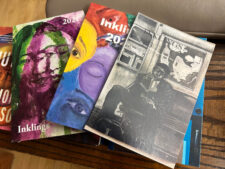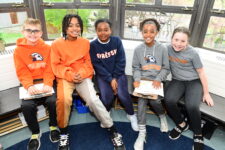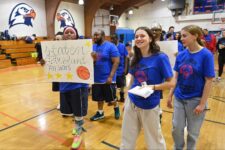Fieldston Upper 10th Graders recently traveled to the Greater Boston area for an immersive trip highlighting what they’ve learned in their history, English, and humanities classes. Ahead of the journey, students prepared to apply their lessons interactively and present their own knowledge for a portion of the trip.
While studying the history of the American Revolution and its hidden stories, 10th Graders were tasked to write a people’s history of Boston, exploring the impact of race, class, gender, and/or sexuality on events in Boston during the War of Independence and into the 19th century.
“The students are the tour guides,” says trip coordinator and History Teacher Jennifer Tammi. “In groups, they research and present on the sites, teaching their classmates about the more traditional history of places like the Boston Massacre, but they’re also instructed to talk about the lesser known stories associated with those sites, which inevitably help highlight the ways in which class, gender, and race connect, and sometimes challenge, the more traditional histories told.”
“The goal of writing a people’s history is to approach dominant histories critically,” the students’ assignment sheet reads. “To question the stories we tell and the myths we construct about the past — and to excavate or highlight the stories that do not get told.”
To be used during their own people’s history walking tour of Boston, groups each constructed a presentation in response to a particular site on the Freedom Trail and the Black Heritage Trail. After preliminary research, groups sought to answer the “essential question” of how the notion of liberty or freedom connects to their specific site. They then worked on written explanations of either sites’ “underground” histories and/or critical interpretations of certain events’ dominant narratives. Student groups also produced a creative response, such as a rap or a skit, to the essential question, to be shared with peers at their assigned landmark.

Assigned locations on the Freedom Trail ranged from the Old South Meeting House, where students were asked to consider a connection to poet Phillis Wheatley, to Boston Common’s Founders’ Memorial, which depicts the arrival of early English settlers as well as Native Americans witnessing the moment. While on the Black Heritage Trail, students presented on sites including the homes of the first African American woman doctor, Rebecca Lee Crumpler, and African American Revolutionary War veteran George Middleton.
The Boston presentations culminated two days of immersive learning and thought. Before arriving in Massachusetts, students visited Connecticut’s Mashantucket Pequot Museum and Research Center to deepen their study of Indigenous resistance, exploring how Indigenous Americans have resisted cultural and physical erasure as part of their history and Humanities units. In the classroom, 10th Graders unpacked mythical histories about Indigenous people and learned about Indigenous American political, economic, and technological contributions and cultural practices. Visiting the Pequot Museum gave students a chance to experience this knowledge firsthand.
“It brings the history of one particular Indigenous group to life as students walk through a reconstructed 17th-century village; see artifacts of everyday life; and hear about how the Pequot people have managed to revive their community since the 1970s,” Tammi says.
Students’ next stop in Concord, Massachusetts, entailed a walk around Walden Pond and engaging in writing exercises related to Henry David Thoreau. These intentional activities reflect upon ECFS’s experiential curriculum engaging students’ hands, hearts, and bodies as much as they engage their minds.
“I think when you learn about something in school, especially in history class, you may get the feeling that it’s not around anymore,” says John K. ’27. “To be able to apply that to a real place with real people, and the fact that so many of these buildings are still standing is amazing. It helps you apply history to your real life, which can instill a lesson in you that learning in a classroom might not necessarily do.”



